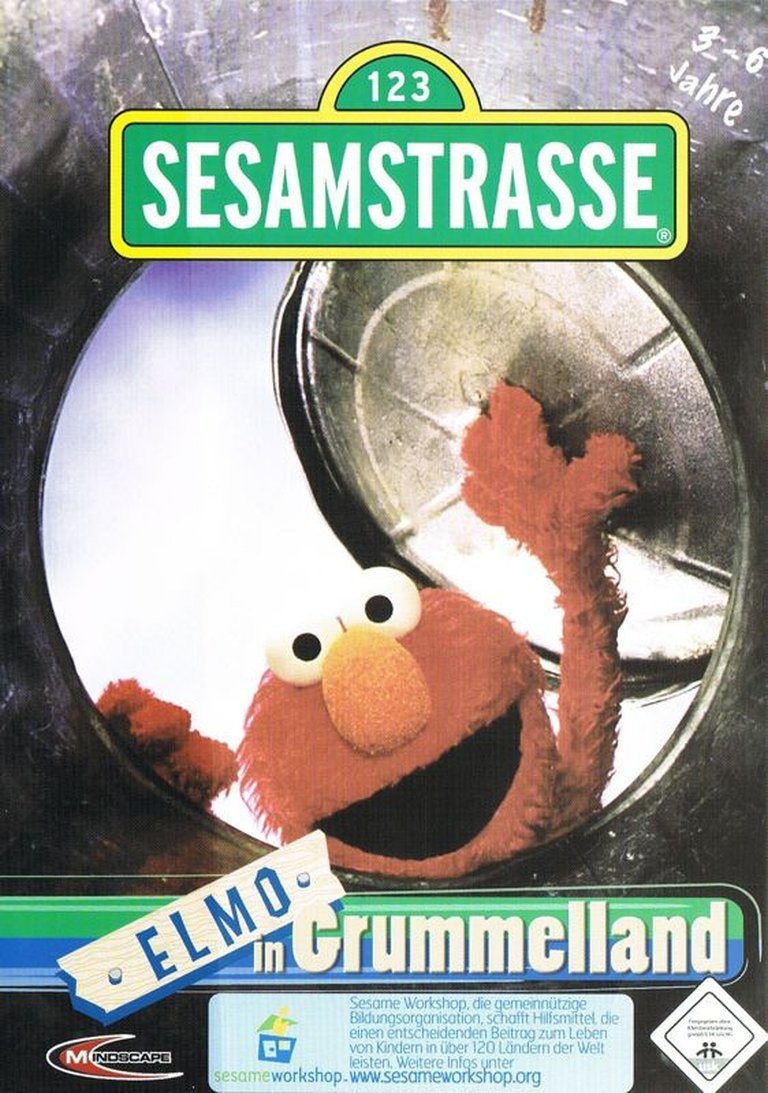- Release Year: 1999
- Platforms: Windows
- Publisher: Mattel Media
- Developer: Children’s Television Workshop
- Genre: Adventure, Educational
- Perspective: 1st-person
- Game Mode: Single-player
- Gameplay: Memory, Mini-games, Point and click, Puzzle
- Setting: Grouchland, Sesame Street
- Average Score: 96/100

Description
The Adventures of Elmo in Grouchland is a 1999 Windows point‑and‑click adventure that follows Elmo and his blanket after they tumble into the garbage‑filled world of the Grouches. Players guide Elmo through this trash‑packed landscape, solving shape‑recognition challenges and completing five mini‑games—including drawing, track building, making music, climbing Mt. Pickanose, and a memory game—to outwit the greedy villain Huxley and retrieve Blanket, all while learning the value of sharing and friendship.
Gameplay Videos
The Adventures of Elmo in Grouchland Free Download
Patches & Updates
Guides & Walkthroughs
The Adventures of Elmo in Grouchland: Review
Introduction
In the pantheon of licensed children’s games, The Adventures of Elmo in Grouchland (1999) occupies a peculiar niche: a multimedia companion to Sesame Street’s second theatrical film, designed to bridge early edutainment and rudimentary gameplay. While overshadowed by its film counterpart’s modest box office reception, the game remains a fascinating artifact of late-’90s preschool gaming—a blend of Sesame Street’s pedagogical ethos and the era’s technological limitations. This review argues that Grouchland succeeds as a child’s first “adventure,” balancing accessibility with skill-building, even as its simplicity and repetitive design reflect the constraints of its time.
Development History & Context
Developed by Children’s Television Workshop (now Sesame Workshop) and published by Mattel Media, Grouchland was released in October 1999 for Windows, followed by a Game Boy Color version by NewKidCo. The game aimed to capitalize on the film’s release while adhering to Sesame Street’s mission of early childhood education.
The late ’90s saw a boom in CD-ROM edutainment titles targeting preschoolers, with studios prioritizing interactive storytelling over mechanical complexity. Grouchland’s development team, including veterans like Wendy Paige Bronfin (producer) and Jason Milligan (creative director), faced the challenge of translating the film’s narrative into a playable experience without overwhelming young users. The result was a hybrid of point-and-click exploration (Windows) and side-scrolling platforming (GBC), designed to run on low-spec PCs and handheld hardware.
Narrative & Thematic Deep Dive
The game mirrors the film’s plot: Elmo’s beloved blanket is lost in Oscar the Grouch’s trash can, leading him into the grimy, obstacle-filled Grouchland. Players guide Elmo through a series of mini-games and environmental puzzles to retrieve the blanket, encountering allies like Grizzy and antagonists like the greedy Huxley.
Thematically, the game reinforces Sesame Street’s core lessons: sharing (Elmo initially refuses to lend his blanket to Zoe), perseverance (navigating Grouchland’s challenges), and problem-solving. Dialogue and character interactions are stripped to synecdochic simplicity, relying on familiar voices (Kevin Clash’s Elmo, Caroll Spinney’s Oscar) to maintain engagement. While narratively linear, the game’s emphasis on cause-and-effect—e.g., rebuilding mine tracks to progress—subtly instills logical reasoning.
Gameplay Mechanics & Systems
The Windows and GBC versions diverge sharply in design:
-
Windows (Point-and-Click Adventure):
Five mini-games structure the experience:- Draw & Seek: Deduce Blanket’s hiding spot via Elmo’s drawings.
- Track-Building: Spatial puzzles to reassemble minecart rails.
- Sound Matching: Identify objects that create specific noises for the Stenchmen’s “music machine.”
- Mountain Climbing: Avoid hazards like goats and slime in a timing-based platformer.
- Memory Game: Replicate a sequence of animal sounds to outwit Huxley.
A map system allows free navigation between zones, and two difficulty settings adjust puzzle complexity. The UI is minimalistic, with cursor-based interactions tailored to motor skill development.
-
Game Boy Color (Side-Scrolling Platformer):
Eight brief levels task players with jumping fire hydrants, ducking debris in a minecart, and evading trash piles. The gameplay is rudimentary, criticized for clunky controls and repetitive tasks, though its simplicity aligns with handheld gaming norms of the era.
Both versions prioritize skill-building: shape/color recognition, pattern identification, and auditory memory. However, the lack of fail states beyond reattempting mini-games (Windows) or losing lives (GBC) limits challenge, reflecting the target demographic’s limited patience.
World-Building, Art & Sound
Grouchland’s visual design faithfully adapts the film’s grungy, colorful aesthetic. The Windows version features vibrant, static backdrops reminiscent of Sesame Street’s puppet-and-prop style, while animated hot spots (e.g., Oscar’s trash can spewing smoke) add dynamism. The GBC version’s pixel art is serviceable but constrained by the hardware’s palette.
Sound design leverages the franchise’s strengths: Elmo’s giggles, Oscar’s grumbles, and snippets of the film’s score (including Michele Darling and Peter Durwood’s compositions) ground players in Sesame Street’s sonic universe. The absence of voice acting in the GBC version is a notable downgrade, replaced by bleeps and bloops that lack the Windows edition’s charm.
Reception & Legacy
Critically, the Windows version fared well, earning a 96% score from SuperKids for its “humor and whimsy” and alignment with developmental goals. The GBC port struggled, criticized for its brevity and lack of depth (40% average from critics). Commercially, neither version achieved mainstream success, though they found niche appeal among Sesame Street’s preschool audience.
Legacy-wise, Grouchland exemplifies early edutainment’s strengths and pitfalls. Its emphasis on skill-building through mini-games influenced later titles like JumpStart Adventures and Reader Rabbit, while its adherence to source material set a template for licensed children’s games. However, its repetitive design and lack of mechanical innovation highlight the genre’s historical limitations.
Conclusion
The Adventures of Elmo in Grouchland is neither a masterpiece nor a failure. It is a conscientious, if unambitious, extension of Sesame Street’s educational mission—a game designed to be a child’s first foray into interactive media. While its gameplay lacks the depth to engage older audiences, its focus on foundational skills and affectionate adaptation of the source material cement its place in the pantheon of late-’90s edutainment. For historians, it is a poignant reminder of an era when “learning through play” was a radical proposition, rendered with earnestness by creators who believed in the power of a red Muppet’s journey through a trash-filled wonderland.